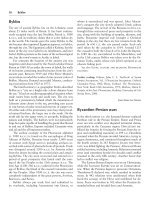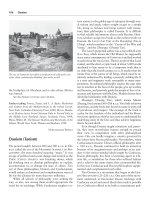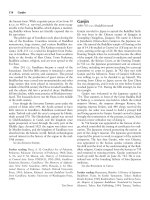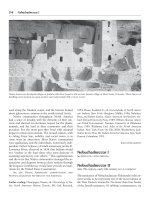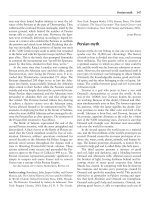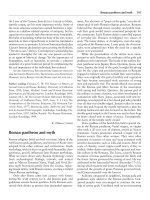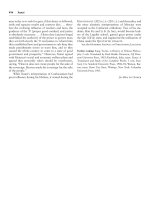Encyclopedia of world history (facts on file library of world history) 7 volume set ( PDFDrive ) 2442
Bạn đang xem bản rút gọn của tài liệu. Xem và tải ngay bản đầy đủ của tài liệu tại đây (80.51 KB, 1 trang )
162
India Act (1935)
Habib, John S. Ibn Sa’ud’s Warriors of Islam. Leiden: Brill,
1978; McLoughlin, Leslie. Ibn Saud: Founder of a Kingdom.
New York: St. Martin’s Press, 1993.
Julie Eadeh
India Act (1935)
The first Government of India Act (1858, after the
Sepoy Rising of 1857) abolished the British East India
Company and put India under British government
administration. A second act in 1909 introduced the
concept of elected government. Still, Indian troops
served in World War I because Britain, not India,
declared India at war with Germany. In 1917 Secretary
of State for India Edwin Montagu promised that India’s
government would gradually permit increased Indian
participation in the administration of India, with the
goal of eventual self-rule. Then the war ended. Although
a third Government of India Act in 1919 gave local
control of “nation building” areas such as education,
it retained law and order and finance for Parliamentappointed governors and officials responsible to them.
This system of power sharing was called dyarchy. Britain’s harsh measures against alleged political extremists
and the Punjab disturbances of 1919, including a massacre of 400 at Amritsar, led to the creation of a national
Indian movement against British control. A nationalist
leader, Mohandas K. Gandhi, rose to the fore.
Gandhi led a movement of noncooperation against
Britain in 1920–22 and a civil disobedience effort in
1930–31. In 1942 he called for the British to “Quit
India.” He led the first negotiations for independence
in 1930 at the Round Table Conferences in London.
Motilal Nehru, father of Jawaharlal Nehru, was also
active in the movement for Indian self-government. He
chaired a committee of the All Parties Conference that
included Muslims. It issued the “Nehru Report” of
1928 that called for a dominion constitution for India
written by Indians.
When the all-British Simon Commission visited
India in 1927–28, it generated protests that the Indian
police repressed violently, leading to the death of Punjabi leader Lalal Lajpat Raj and rallying a new generation
of Indian nationalist leaders. Its report in 1930 rejected
dyarchy and determined that local autonomy was in
order. It proposed the retention of communal electorates for Muslims and Hindus until tensions calmed. The
British government drafted legislation to provide the
reforms. The Round Table Conferences decided that
Britain would unite the princely states with the provinces directly under its administration and eventually
give the combined government of India dominion status. The congress and the Muslims split over details,
leaving the decisions to the British.
The Government of India Act provided autonomy
to the 11 Indian provinces it created. It separated Aden
and Burma from India, increased the pool of eligible
voters from 7 million to 35 million, and created two
new provinces—Sind, split from Bombay, and Orissa,
split from Bihar. Provincial assemblies included more
elected Indian representatives. The governor, often British, retained the rights of intervention in emergencies.
The first elections under the act occurred in 1937.
The act was the longest bill the British parliament
ever passed. Parliament did not trust Indians, particularly Indian politicians, and wanted to be sure there was
no room for interpretation or adjustment. Theoretically,
it provided self-government in all areas but defense and
foreign affairs. In practice, it reserved extensive powers for British intervention in Indian affairs through the
British-appointed viceroy and provincial governors who
were responsible to the secretary of state for India.
The act also had provisions for the formation of a
federal government, but because half the states never
agreed to its terms, a federation never occurred. It also
failed to address the religious problem. Hindus were twothirds of India’s population, leading to concerns by the
minority Muslims that they would be treated unfairly.
When the Hindu-dominated Congress Party won eight
of the 11 provincial elections in 1937 the Muslims led
by Mohammad Ali Jinnah began demanding a separate
state, Pakistan.
Althought the British parliament thought it was
realistic to federate states of widely diverging size,
sophistication, and structure, it did not happen. The
princes failed to recognize that they could control the
federation if they united in support of it. Instead, they
pursued their own interests with the restult that the federation never received the requisite majority.
The act failed to attract significant support from moderates, in large part because they did not trust the British.
The Hindu electorate preferred the Congress Party, and
the Congress Party wanted dominion status equal to that
granted to the white dominions, which included control
over foreign as well as internal affairs.
The first viceroy after the act was passed was Lord
Linlithgow. He was intelligent, honest, hardworking,
serious, and committed to the success of the act. He
was also stolid, unimaginative, legalistic, and unable
to deal with people other than those in his own circle.

